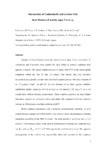Mostrar o rexistro simple do ítem
Interactions of Cadmium(II) and protons with dead biomass of marine algae Fucus sp
| dc.contributor.author | Herrero, Roberto | |
| dc.contributor.author | Cordero Pérez, Bruno | |
| dc.contributor.author | Lodeiro, Pablo | |
| dc.contributor.author | Rey-Castro, Carlos | |
| dc.contributor.author | Sastre de Vicente, Manuel | |
| dc.date.accessioned | 2005-11-09T19:27:43Z | |
| dc.date.available | 2005-11-09T19:27:43Z | |
| dc.date.issued | 2005-11-09T19:27:43Z | |
| dc.identifier.issn | 0304-4203 | |
| dc.identifier.uri | http://hdl.handle.net/2183/179 | |
| dc.description | Enviado á revista Marine chemistry | es_ES |
| dc.description.abstract | [Abstract] Samples of dead biomass from the marine brown algae Fucus ceranoides, F. vesiculosus and F.serratus were studied for their ability to remove cadmium from aqueous solutions. The metal sorption process is rapid, with 90% of the metal uptake completed within the first 25 min. of contact. The kinetic data was described successfully by a pseudo second order chemical sorption process with rate constants of ca. 0.6 g·mmol-1·min-1. At pH 4.5, the raw biomass of the three species exhibited equilibrium uptake capacities for Cd as high as 0.8 mmol·g-1 (90 mg·g-1), on a dry weight basis, without chemical pretreatment. These sorption capacities are much higher than those reported for activated carbon and chitin. The sorption of Cd was found to increase as pH increases, reaching a plateau at pH 5. Batch sorption experiments and continuous potentiometric titrations of acid-treated biomass samples in 0.05M NaNO3 were used to derive thermodynamic binding parameters according to the NICCA model. The total amount of acid sites was 2.4-2.9 mmol·g-1, with median values of the affinity distribution for protons and cadmium ions, log HK~ and log CdK~, of 3.7 and 2.69 respectively (conditional values). The apparent heterogeneity of the sorbent was successfully taken into account by the empirical 1 NICCA isotherm, which described very well the competition between protons and metal ions, in contrast with a simpler discrete competitive Langmuir model. The experimental results demonstrate that these seaweeds constitute a promising, efficient, cheap and biodegradable sorbent biomaterial for cadmium removal from wastewaters. This use would represent an example of exploitation of a renewable marine resource in water treatment technologies for the prevention of heavy metal pollution in the environment. | es_ES |
| dc.description.sponsorship | Ministerio de Ciencia y Tecnología; BQU2002-02133 | |
| dc.description.sponsorship | Xunta de Galicia; PGDIT02TAM10302PR | |
| dc.format.mimetype | application/pdf | |
| dc.language.iso | eng | es_ES |
| dc.subject | Heavy metals | es_ES |
| dc.subject | Marine algae | es_ES |
| dc.subject | Biosorption | es_ES |
| dc.subject | Wastewater treatment | es_ES |
| dc.subject | Potentiometric titration | es_ES |
| dc.subject | Voltammetry | es_ES |
| dc.title | Interactions of Cadmium(II) and protons with dead biomass of marine algae Fucus sp | es_ES |
| dc.type | info:eu-repo/semantics/preprint | es_ES |
| dc.rights.access | info:eu-repo/semantics/openAccess | es_ES |






